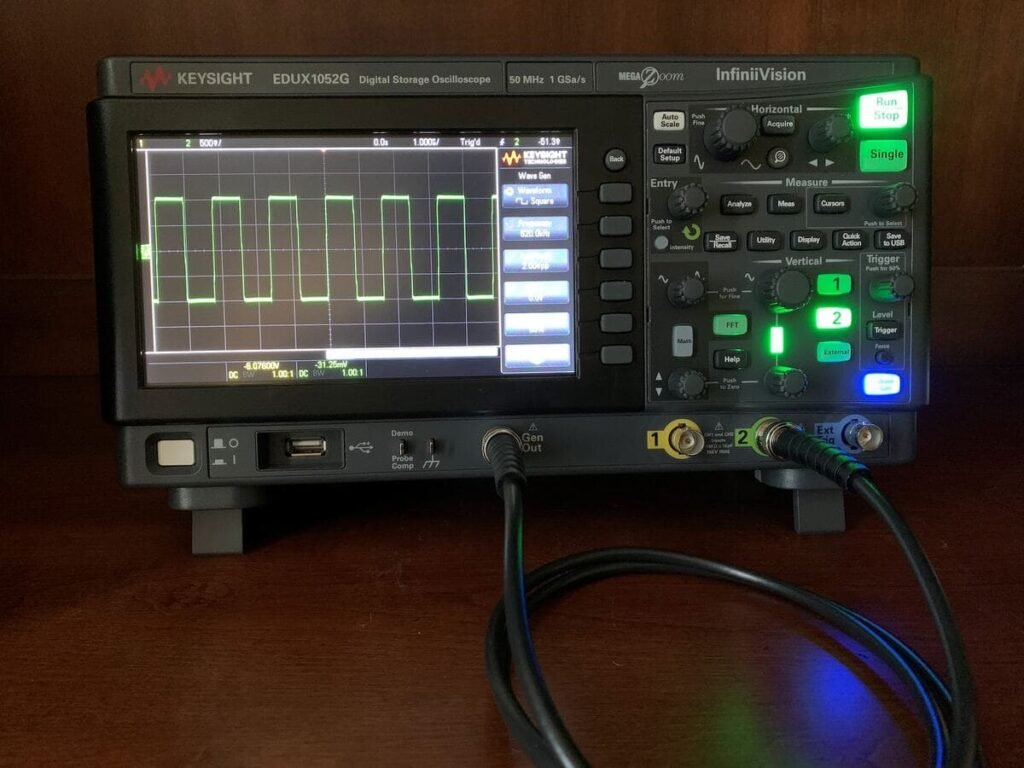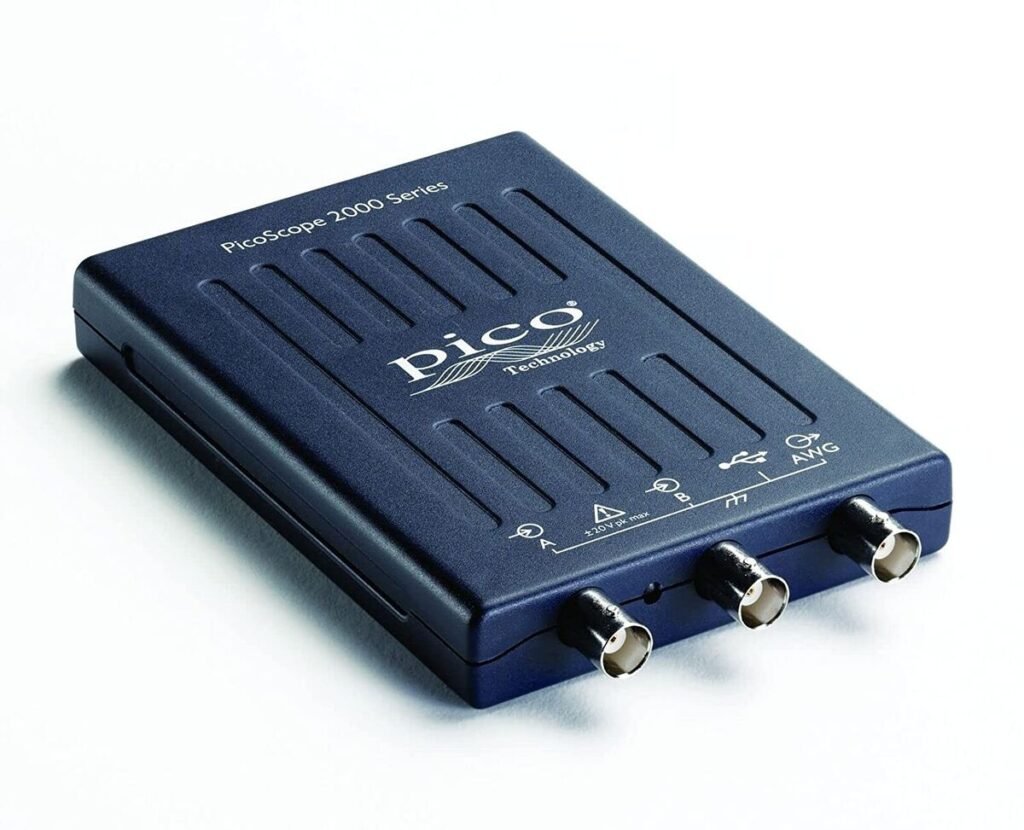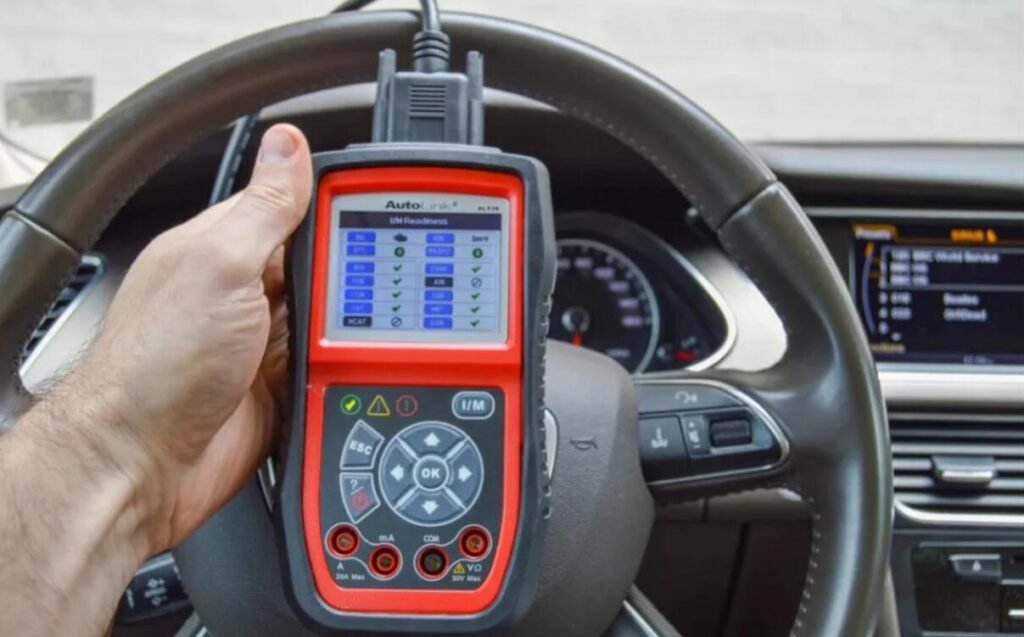How to Choose The Right Oscilloscope under $257 (in 2024)
For many engineers, buying a new cheap oscilloscope can be overwhelming: there are hundreds of different models to choose from, with very variable prices and specifications.
This article will guide you through the maze of things to keep in mind and, hopefully, it will help you avoid a mistake that could end up being expensive.
Table could not be displayed.Don’t forget to also peruse our oscilloscopes, spectrum analyzers, and other electronics lab tools.
An oscilloscope is an essential tool for troubleshooting electronic systems. An oscilloscope can be used to find the source of a problem, identify a signal’s frequency, and view how a signal changes over time.
To use an oscilloscope effectively, you need to understand which features are useful in your given application, how they impact your test setup, and which oscilloscope might be best suited to execute your testing.
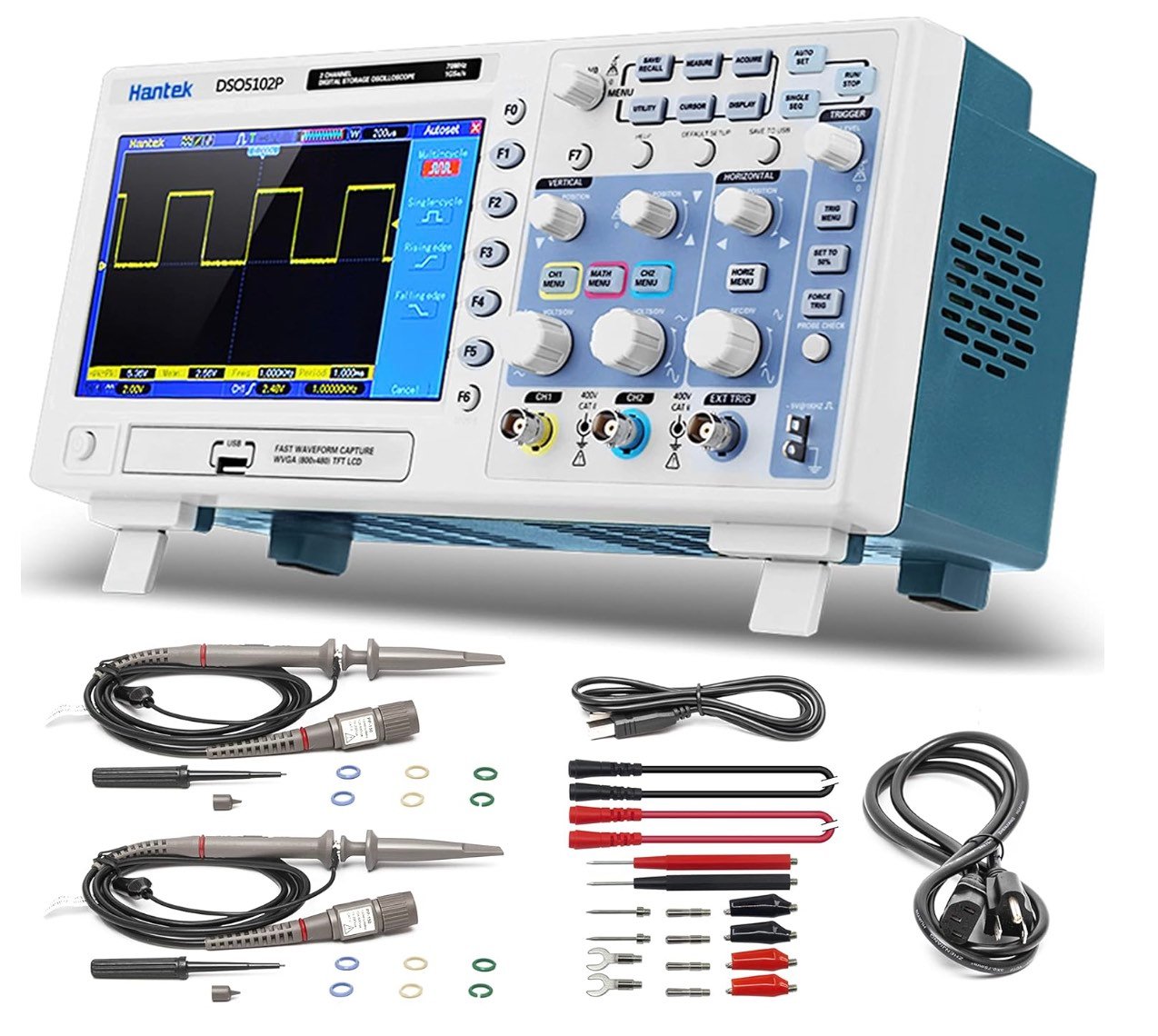

Oscilloscopes generally fall into three broad categories: analog probes, digital storage oscilloscopes (DSOs), and hybrid oscilloscopes. Each has its own strengths, weaknesses, and uses. Each type of scope also has different types of probes that are specific to it.
Whether you’re purchasing an oscilloscope for professional or personal use, there are a few attributes that you should pay attention to before making a purchasing decision. In this post, we’ll discuss these attributes so that you can make the perfect selection!
First Things First
The first step in choosing an oscilloscope is not to look at advertisements or specifications, but to spend some time thinking about what you will use it for and where you will do it:
- Where will you use the oscilloscope (on a work table, where the customer is, under the hood of a car …)?
- How many signals do you need to measure at the same time?
- What are the minimum and maximum amplitudes of the signals you have to measure?
- What is the highest frequency of a signal that you have to measure?
Are the signals repetitive or single shot? - Do you have to see the signals in the frequency domain (spectrum analysis) as well as in the time domain?
- When you have the above notions, you can start to consider which oscilloscope is best for your applications.
Analog Or Digital
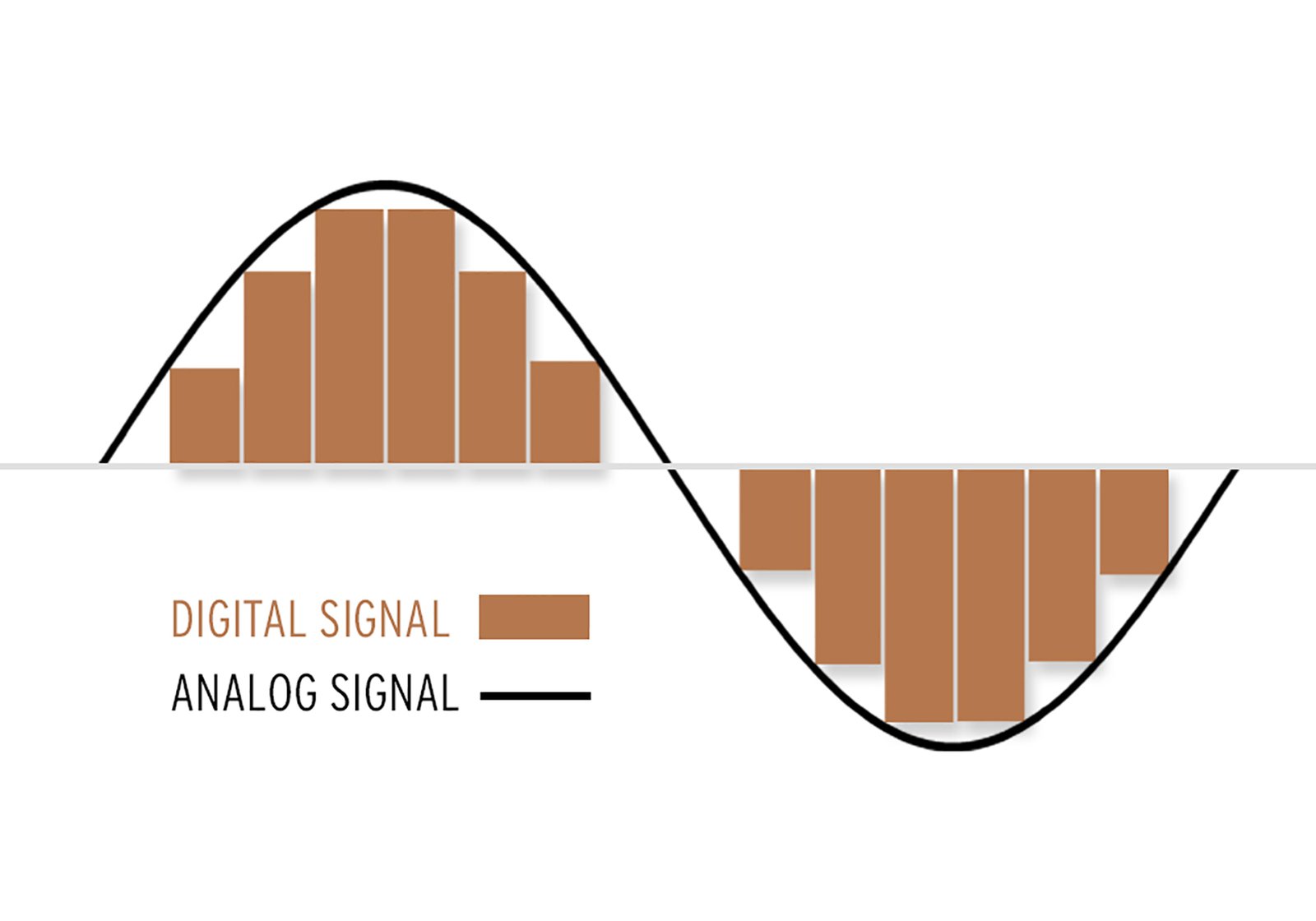
This article focuses on Digital Storage Oscilloscopes (in English, Digital Storage Oscilloscopes, or DSO), as they represent the majority of new oscilloscopes that can be purchased today. But before describing what to look for in a digital oscilloscope, it is necessary to start by talking briefly about analogs.
Cheap oscilloscope Most electronic engineers will have used an analog oscilloscope at some time, and they will be familiar with their appearance and operation. In fact, many of the people who buy oscilloscopes today do so to replace an analog with a digital one.
Although there are still some engineers who love the feel (and warmth) of analog oscilloscopes, they have very few (or none) characteristics that cannot be overcome by a DSO.


But if the idea of buying a cheap analog oscilloscope still tempts you, you will discover that your options are limited. There are only a few manufacturers that continue to produce analog oscilloscopes. And some of the models that are still for sale are based on fairly old technology and usually have very limited performance.
Digital Oscilloscope
Buying a second-hand analog oscilloscope may seem like a good decision from an economic point of view. However, before doing so check the availability of spare parts, since high repair costs can make the purchase end up expensive.
There are other criteria that add weight to the debate between analog and digital. Specifically, digital oscilloscopes:
- They are small and portable
- They have the highest bandwidths
- Allow single shot
- They have color screens
- They provide measurements on screen
- They have simple user interfaces
- They provide storage and printing


And if you are looking for the best digital oscilloscope look at the comparison that we link to you because we talk about the best models of this type.
Modern DSOs, with their PC connectivity, can also be fully integrated with Automatic Test Equipment (ATE). In addition, the DSO is often used as a front-end of a high-speed data acquisition system, making the cost per channel much more economically viable.
Oscilloscope Bandwidth
The first feature to consider is bandwidth. It can be defined as the maximum frequency of the signal that can pass through the front-end amplifiers. Therefore, the analog bandwidth of your oscilloscope must be higher than the maximum frequency you want to measure (in real time).
Bandwidth alone is not enough to ensure that a DSO is able to accurately capture a high frequency signal. The aim of oscilloscope manufacturers is to achieve a specific type of frequency response with their designs. This answer is known as Maximum Envelope Flat Delay (MFED).
Such a frequency response provides excellent pulse fidelity with minimal overshoot, undershoot and transient oscillation (ringing). However, since a DSO is composed of amplifiers, attenuators, analog-digital converters, interconnections and relays, the MFED response is an objective that can only be achieved in approximate form, never complete.
At 50MS.
It is worth bearing in mind that most oscilloscope manufacturers define the bank width as the frequency at which a sine wave input signal will be attenuated to 71% of its true amplitude (the point of -3 dB) . Or, put another way, manufacturers allow the trace shown to have a 29% error with respect to the input before considering it a problem.
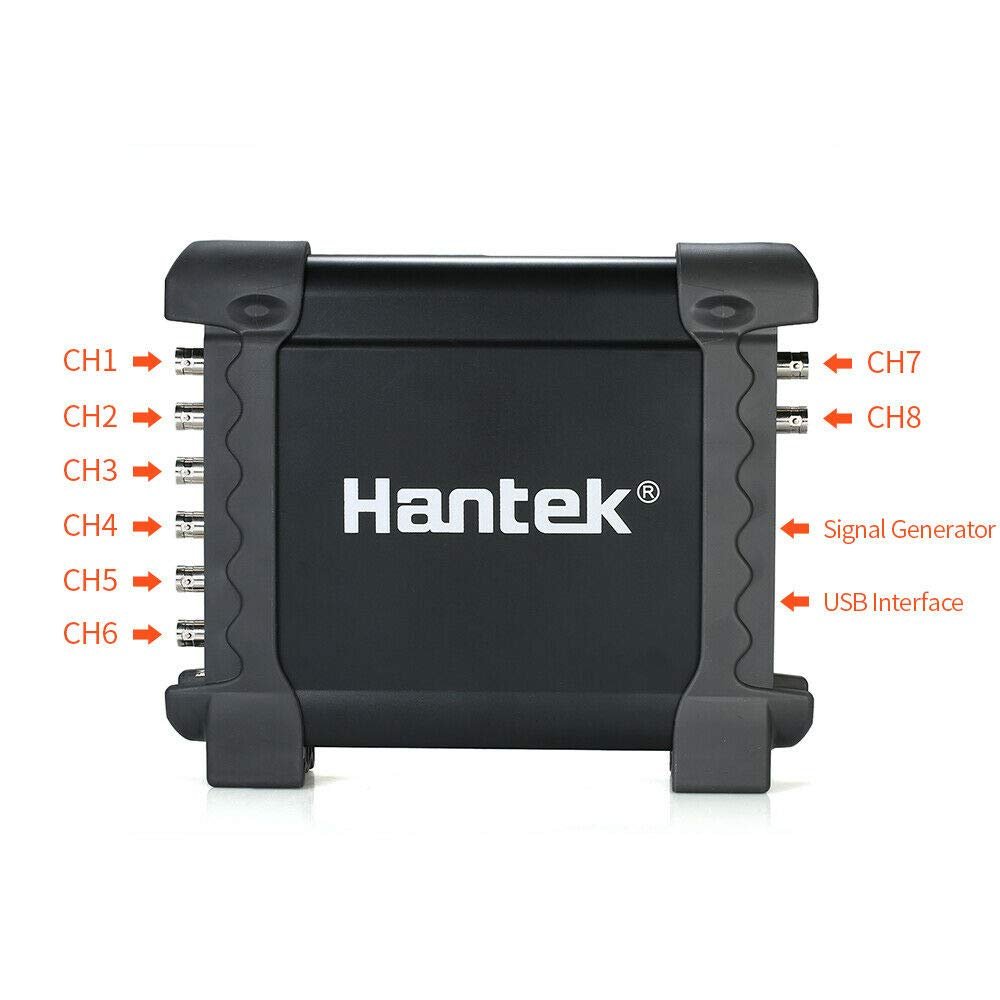

Also remember that if your input signal is not a pure sine wave, it will contain higher frequency harmonics. For example, a pure 20 MHz square wave displayed on an oscilloscope with a bandwidth of 20 MHz will be displayed as an attenuated and distorted wave.
As a general rule, try to buy an oscilloscope with a bandwidth five times greater than the maximum signal frequency you want to measure. Unfortunately, broadband oscilloscopes are expensive, so you may have to make some sacrifice.
In other oscilloscopes, the indicated bandwidth is not available in all voltage ranges, so check the specifications carefully.
Oscilloscope Sampling Rate
With analog oscilloscopes, life was simple: you just had to choose the bandwidth you needed. However, in digital both the sampling frequency and the depth of memory are equally important. For DSOs, the sampling frequency is usually specified in mega samples per second (MM / s, or MS / s in English) or gig samples per second (GM / s, or GS / s in English).
The Nyquist criterion states that the sampling frequency must be at least twice the maximum frequency you want to measure: for a spectrum analyzer this may be true, but for an oscilloscope, you need at least 5 samples to accurately reconstruct the shape of a wave
Most oscilloscopes have two different sampling frequencies (modes), depending on the signal being measured: real-time and equivalent-time sampling (ETS in English, that is, Equivalent-Time Sampling), which is often Called repetitive sampling.
However, the ETS only works if the signal you are measuring is stable and repetitive since this mode works by building the waveform from successive readings.
For example, the 12-bit Pico Technology ADC-212/100 is capable of sampling at 5 GS / s. This sounds great, but remember that if the signal is transient or changing (for example, a video signal), then the ETS will not work and you will have to resort to real-time bandwidth (single shot), which is usually much smaller.
One tip: oscilloscope manufacturers like to highlight the specification that sounds best, so you may have to look carefully at the specifications to find out if the advertised sampling frequency applies to all signals or only repetitive ones. You may find that the oscilloscope you plan to buy is not the most suitable for your specific case.
On the other hand, some oscilloscopes have different sampling frequencies, depending on the number of channels used. Normally, the sampling frequency in single-channel mode is twice that in dual-channel mode: again, check the specifications.
Memory Depth
It is possible that the depth of memory is the worst understood aspect of a DSO, which is a shame since it is one of the most important.
DSOs store the captured samples in a buffer memory. Therefore, given a given sampling frequency, the buffer size determines how long it can capture a signal before the memory becomes full.
The relationship between the sampling frequency and the memory depth is important: an oscilloscope with a high sampling rate but a small memory will only be able to fully use its sampling frequency for short periods of time.
Real world example
To better understand the relationship between bandwidth, sample rate and memory depth, it makes sense to consider an example of the real world. Imagine that you are trying to capture a USB data frame (1.1). A data frame lasts 1 ms and transmits serial data at 12 Mbps. To simplify our analysis, we can assume that we have to capture a square wave at 12 MHz for 1 ms.
Bandwidth: to measure the 12 MHz signal, we need an absolute minimum of 12 MHz, but this will provide a very distorted signal, so the best will be a bandwidth of at least 50 MHz.
Sampling frequency: to reconstruct the 12 MHz signal, we need about 5 points per wave, so a minimum sampling rate of 60 MM / s is required.
Memory depth: to capture data at 60 MM / s for 1 ms, a minimum memory depth of 60,000 samples is required.
Resolution And Precision
In digital electronics, a 1% change in the signal is not usually a problem. However, in audio electronics, a distortion or noise of 0.1% can be a disaster. Most modern DSOs are optimized for use with fast digital signals and only offer an 8-bit resolution (ADC), so that they can detect a change in the signal of 0.4% at most.
With 8 bits, the voltage range is divided into 256 vertical steps (28 = 256). A chosen range of ± 1 V corresponds to about 8 mV per step. This may be suitable for viewing digital signals, but leaves much to be desired to display analog signals, especially if the spectrum analyzer function is used (if available).
For applications such as audio, noise, vibration and monitoring sensors (temperature, current, pressure, etc.), a cheap 8-bit oscilloscope is usually not suitable, and you should consider 12 or 16-bit alternatives.
With regard to the accuracy of a DSO, it is not usually considered too important. You can take measurements with a margin of a few percentage points (most 8-bit DSOs claim to have 3-5% accuracy in direct current). However, to get more precise measurements, you should use a multimeter.
Now, with a higher-resolution oscilloscope, more precise measurements (1% or better) are possible, so you won’t need to use a multimeter!
Oscilloscopes that have both high resolution (12 bits or more) and high precision in direct current are often called precision oscilloscopes.
Shooting Functions
The trigger function of an oscilloscope synchronizes the horizontal scan at the correct point of the signal. This is essential to describe the signal clearly. Trigger controls allow you to stabilize repetitive waves and capture single-shot waves.
Depending on the type of waves you analyze, it is worth taking a look at the shooting options offered by a manufacturer. All digital oscilloscopes offer the same basic shooting options (source, level, slope, pre/post shot), but differ in the most advanced.
The fact that these more advanced shooting functions are useful or not will depend again on the signals you are going to measure. Pulse triggers are useful for digital signals, and an automatic disk/memory save option can be of great help in detecting intermittent failures.
Some triggers for specific applications (for example, for testing hard drives) are usually available as extras at an additional cost and are installed as a software or firmware update.
If you are likely to use one of these extras at an additional cost, do not be afraid to negotiate with the seller. It is not uncommon for these “optional extras” to end up being offered free to close a sale.
Input Ranges And Probes
A typical cheap oscilloscope will offer selectable full-scale input ranges from ± 50 mV to ± 50 V. As it is possible to measure higher voltages using 10: 1 and 100: 1 attenuator probes, the important thing in this case is to verify that the oscilloscope has a Voltage range small enough for the signals you want to measure.
If you usually measure small signals (less than 50 mV), then consider buying a cheap oscilloscope with a resolution of 12 or 16 bits. One of 16 bits has 256 times the vertical resolution of one of 8 bits, making it possible to “zoom” in signals of the order of millivolts and microvolts.
On the other hand, check that the probes you plan to use match the oscilloscope bandwidth or exceed it. Some manufacturers reduce costs by providing inferior quality probes with a cheap oscilloscope.
In this way, they only offer larger bandwidth probes, necessary to get the most out of the oscilloscope, as optional extras. Most oscilloscope probes allow switching between a 1: 1 and 10: 1 attenuation.
Whenever possible, use the 10: 1 configuration, as it minimizes the load on the circuit being analyzed and increases the overload protection if you accidentally connect them to a high voltage.
For signals with very high speeds (greater than 200 MHz), the passive probes begin to have problems caused by the capacitance of the cable that returns to the oscilloscope. This can be solved by investing in an active FET probe, which has an amplifier buffer at the tip of the probe.
To measure high voltages, for example, ± 100 V, such as those of the power sockets and three-phase voltages, the safest option is to use an oscilloscope probe with differential isolation.
Form Factor
Broadly speaking, DSOs can be classified into three categories: traditional desktop, handheld, and PC-based.
Desktop digital oscilloscopes specifically designed for that use usually have the highest performance, and that will be reflected in the cost. Features such as FFT spectrum analysis, PC interfaces, hard drives, and printers are usually optional extras that are expensive.
On the other hand, handheld oscilloscopes have obvious advantages for an engineer who usually travels, but care must be taken with poor quality screens (difficult to read in sunlight) and short-lived batteries. In addition, for a given level of performance, they are also usually the most expensive option.
As for PC-based oscilloscopes, they are increasingly popular because they offer considerable savings over their desktop equivalents. The reason for the cost reduction is evident: when using the mass-produced PC that you already have on your desktop, you have a large color screen, a fast processor, hard drives and a keyboard for free.
Therefore, they are a great option if you want to buy a cheap oscilloscope. The ability to export data to word processors and spreadsheets with a couple of mouse clicks is also a great advantage.
There are PC-based oscilloscopes of two types: external and internal. Inmates usually come with PCI cards that can be connected to the computer. In theory, it should be the most affordable option, but this is not always the case.
The main disadvantage of PC cards is noise: the inside of a PC can be a very noisy electrical environment, and some cards suffer from it. Another problem is mobility since PC-based oscilloscopes are tied to use on a desktop PC.
On the other hand, external PC-based oscilloscopes are shaped like a small box that connects to the PC through a USB port. By keeping all analog electronics out of the PC, the noise problem is avoided. A second advantage of these oscilloscopes is mobility: they can be used with both desktop PCs and laptops.
Amazon Review Feedback on How to Choose The Right Oscilloscope under $257
Choosing the right oscilloscope under $257 requires careful consideration of your specific needs and the features offered by different models. Based on customer feedback, several options stand out in this price range. The FNIRSI 1014D offers great value and ease of use, with positive remarks on its portability and user interface, though some users debate its accuracy. The Rigol DS1054Z is widely praised for its quality, features, and responsiveness, making it suitable for both amateur and professional use. Hantek’s DSO5102P impresses with its intuitive design and compact form factor, though opinions vary on its speed and accuracy. The Siglent Technologies SDS1202X-E stands out for its higher bandwidth and comprehensive feature set, appealing to those needing more advanced capabilities. When choosing, consider factors such as bandwidth (ranging from 50MHz to 200MHz in these models), number of channels, sample rate, and additional features like built-in function generators or protocol analyzers. User interface and software support are also crucial, especially for beginners. While higher bandwidth and more features generally come at a premium, even budget-friendly options in this range offer impressive capabilities for most hobbyist and educational needs. Ultimately, the best choice depends on balancing your specific requirements with the strengths of each model.
Reviewer Final Comments
Like the dinosaurs, the analog oscilloscope had its moment. However, the performance and cost of digital oscilloscopes guarantee they are here to stay. It only remains to decide which one to buy.
When choosing between different oscilloscopes, make sure of the following:
Try before you buy, and don’t be afraid to compare different oscilloscopes from different manufacturers. If a seller does not offer you a guarantee of “if you are not satisfied, we will refund your money”, then it is better that you do not buy anything.
For the most expensive oscilloscopes, ask for demonstrations with the real signals you want to measure, not just with signals that show their goodness.
When buying any cheap or expensive oscilloscope, ask about updates and check what is included in the price. In the case of PC-based oscilloscopes, make sure the software is included and ask if you will have to pay for the updates. For desktop oscilloscopes, check the cost of the cables and software to connect them to the PC and/or to printers (it can be a 50% additional cost).
Check the warranty duration. If your unit breaks down when you are using it, will the seller leave you another while it is being repaired? Finally, look for independent analysis of oscilloscopes on the Internet.


